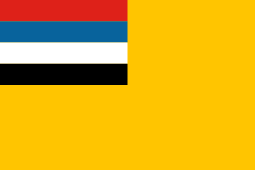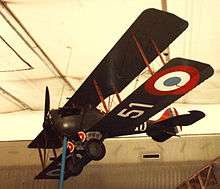Nieuport-Delage NiD 29
| NiD 29 | |
|---|---|
 | |
| Role | Single-seat biplane fighter |
| National origin | France |
| Manufacturer | Nieuport-Delage |
| First flight | 21 August 1918 |
| Introduction | 1922 |
| Primary users | French Air Force Belgian Air Force |
| Number built | 250+ |
|
| |
The Nieuport-Delage NiD.29 was a French single-seat biplane fighter (C.I category)[1] designed and built by Nieuport-Delage for the French Air Force.
Design and development

The NiD.29 was an equal-span biplane with ailerons on both upper and lower wings. It had a fixed tailskid landing gear, a nose-mounted engine and a single open cockpit for the pilot. The prototype NiD 29 first flew on the 21 August 1918 powered by a Hispano-Suiza 8Fb engine piston engine, it performed well in test but could not achieve the required ceiling. The second prototype was modified with an increased wingspan and on achieving the required ceiling it was ordered into production in 1920, becoming the fastest service fighter in the world at that time. Production aircraft did not have ailerons on the upper wing and the lower wing ailerons were increased in size.
The first deliveries were made in 1922 to the French Air Force and the type was popular although it did have a tendency to enter a flat spin. The French military bought 250 aircraft which were built by Nieuport and seven other companies. The Ni-D 29 was to become an important fighter in the 1920s with purchases of 30 by Spain (including 10 Spanish licence built aircraft), 108 by Belgium (87 licensed built by SABCA). The Italian Regia Aeronautica bought 175 aircraft including 95 built by Macchi as the Macchi-Nieuport 29 and 80 built by Caproni. Sweden bought nine aircraft and designated them J 2. The Japanese company Nakajima bought a pattern aircraft and built 608 for the Imperial Japanese Army as the Ko-4.
Racing versions of the aircraft were developed and they gained eight world speed records and won the 1920 Gordon Bennett Trophy and the 1922 Coupe Deutsch de la Meurthe competition.[2]
Operational history
Three NiD 29s were modified for reserve Captain Joseph Sadi-Lecointe in November 1925 and used on seventy sorties against insurgents in Morocco using bomb racks with six 10 kg bombs.[3] Spanish aircraft were also involved in similar operations in North Africa.
Variants
- Nieuport Ni.29
- Prototype for series, powered by a 240 kW (320 hp) Hispano-Suiza 8Fb engine.
- NiD.29 C.1
- Production aircraft, powered by 240 kW (320 hp) Hispano-Suiza 8Fb engines.
- NiD.29 B.1

- Small number of conversions as an experimental assault version to carry six 10 kg (22.0 lb) bombs.
- NiD.29bis
- Prototype only with reduced wing area and steerable tailskid, powered by a 240 kW (320 hp) Hispano-Suiza 8Fb engine.
- NiD.29G
- Prototypes fitted with a Gnome Monosoupape 9N rotary engine, two later converted to take a Hispano engine and fitted with twin floats and an auxiliary tail float for the Grand Prix de Monaco in 1923.
- NiD.29D
- Conversion with an engine driven supercharger for an attempt on the altitude record, reached 7,000 m (23,000 ft).
- NiD.29 ET.1
- Trainer variant with a 134 kW (180 hp) Hispano-Suiza 8Ab engine and a single synchronised Vickers machine-gun, three built.
- NiD.29 SHV

- Seaplane for the 1919 Schneider Trophy contest with reduced wingspan and military equipment removed, two aircraft built and one was also entered in the 1921 event but neither aircraft flew in the races. Powered by a 220 kW (300 hp) Hispano-Suiza 8Fb engine
- NiD.29V
- Lightweight racer developed in 1919 with a wingspan reduced to 6.00m (19ft 8¼in), powered by a 240 kW (320 hp) Hispano-Suiza 8Fb engine, three built.
- NiD.29Vbis
- One-off conversion with an enclosed cockpit to gain more speed, the pilot had small teardrop windows on each side with little forward visibility. Powered by a Hispano-Suiza 8Fb engine boosted to give 250 kW (330 hp). On 12 December 1920, Sadi-Lecointe flew the NiD-29Vbis to a new world speed record of 313.043 km/h (194.516 mph; 169.030 kn). The aircraft was lost in a landing accident in 1921.
- NiD.32Rh
- 180hp Le Rhone rotary powered derivative for use by the French Navy as a carrier fighter. One converted.
- NiD.33 E.2
- Two-seat trainer with conventional square-section fabric-covered fuselage. Small numbers used by Japan.
- NiD.40 C.1
- High altitude fighter with Rateau turbocharger
- NiD.40R
- One-off modification of NiD.40 C.1 with extended wings and new tail for high-altitude record flights. Later fitted with floats.
- Nakajima Ko-4
- Japanese licence-built NiD.29, 608 built.
Operators
- Imperial Japanese Army as Ko.4
 Manchukuo
Manchukuo- A single ex-Japanese NiD 29 formed the initial equipment of the Manchukuo Air Force in 1937.[4]
 Sweden
Sweden
- Royal Siamese Air Service as บ.ข.๔ (B.Kh4 or fighter type 4)
Survivor

A single example survives at the Musée de l'Air et de l'Espace in Paris although it is not presently on display.
Specifications (NiD 29)
Data from The Illustrated Encyclopedia of Aircraft[5]
General characteristics
- Crew: 1
- Length: 6.49 m (21 ft 3½ in)
- Wingspan: 9.70 m (31 ft 10 in)
- Height: 2.56 m (8 ft 4¾ in)
- Wing area: 26.70 m2 (287.41 ft2)
- Empty weight: 760 kg (1,675 lb)
- Gross weight: 1,150 kg (2,535 lb)
- Powerplant: 1 × Hispano-Suiza 8Fb V-8 piston engine, 224 kW (300 hp)
Performance
- Maximum speed: 235 km/h (146 mph)
- Range: 580 km (360 miles)
- Service ceiling: 8,500 m (27,885 ft)
- Rate of climb: 6.06 m/s (1194.26 ft/min)
Armament
- 2 × fixed forward-firing 7.7 mm (0.303 in) Vickers machine guns
See also
- Related lists
References
| Wikimedia Commons has media related to Nieuport-Delage NiD 29. |
Notes
Bibliography
- Andersson, Lennart. A History of Chinese Aviation:Encyclopedia of Aircraft and Aviation in China until 1949. Taipei, Taiwan: AHS of ROC, 2008. ISBN 978-957-28533-3-7.
- Illustrated Encyclopedia of Aircraft (Part Work 1982-1985). London: Orbis Publishing, 1985.
- Taylor, John W. R. and Jean Alexander. Combat Aircraft of the World. New York: G.P. Putnam's Sons, 1969. ISBN 0-71810-564-8.
- Taylor, Michael J. H. Jane's Encyclopedia of Aviation. London: Studio Editions, 1989. ISBN 0-517-69186-8.